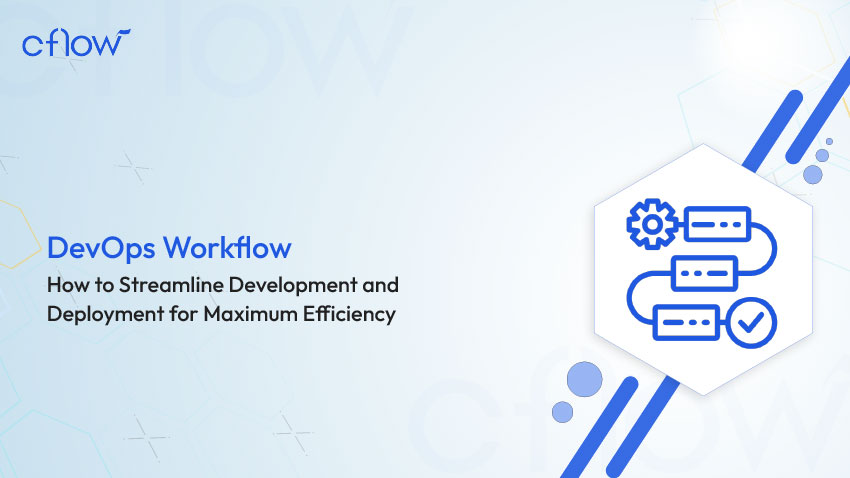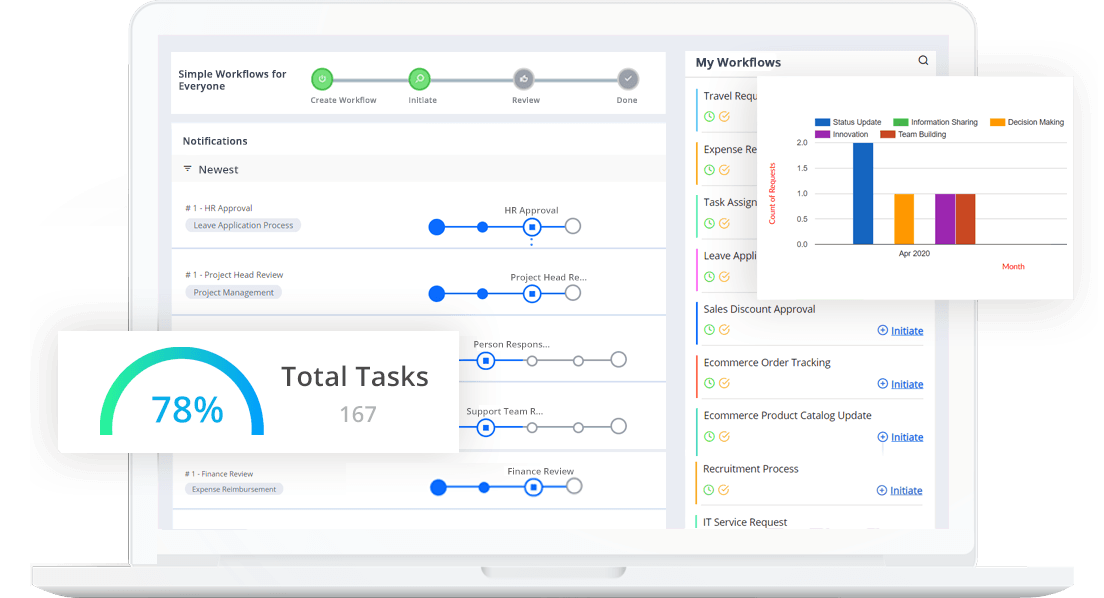DevOps Workflow: How to Streamline Development and Deployment for Maximum Efficiency

Key takeaways
- A DevOps workflow integrates development and IT operations, streamlining software deployment through automation, collaboration, and continuous monitoring.
- Businesses adopting DevOps processes experience 46x more frequent code deployments and 2555x faster lead times than competitors using traditional development models.
- DevOps fosters technical scalability, cost efficiency, and improved product quality, helping teams deliver software updates 60% faster while maintaining system stability.
- Implementing a DevOps workflow strategy ensures agility, reduces human error, and enhances customer satisfaction by enabling faster, more reliable software releases.
Modern software development requires speed, efficiency, and agility to stay competitive. Companies that still rely on traditional software development models often struggle with long development cycles, siloed teams, and inefficient deployments. This is where DevOps workflow comes into play.
A DevOps workflow automates and streamlines the software development, integration, testing, and deployment processes, allowing development and operations teams to collaborate seamlessly. By eliminating manual bottlenecks and integrating CI/CD pipelines, automated testing, and infrastructure as code (IaC), DevOps accelerates product delivery without compromising stability.
According to Puppet’s State of DevOps Report, high-performing DevOps teams deploy 200 times more frequently and recover from failures 24 times faster than non-DevOps teams. The ability to respond quickly to customer demands, security vulnerabilities, and market trends makes DevOps a game-changer for businesses.
In this guide, we’ll explore the DevOps workflow and its benefits, key phases, challenges, and best practices to help organizations implement a robust strategy.
Table of Contents
What Is a DevOps Workflow?
A DevOps workflow is a structured framework that integrates software development (Dev) and IT operations (Ops) to streamline the software delivery lifecycle. It emphasizes automation, collaboration, and continuous feedback to enhance efficiency, minimize errors, and accelerate releases. DevOps workflows break down traditional silos between teams, ensuring that code development, testing, deployment, and monitoring happen in a seamless, iterative manner.
By leveraging CI/CD pipelines, automation tools, and real-time monitoring, businesses can improve software reliability, security, and scalability. This approach ensures that new features, bug fixes, and updates are delivered rapidly while maintaining high-quality software performance.
How Does a DevOps Workflow Work?
A DevOps workflow consists of six key phases, ensuring continuous software development, testing, and deployment with minimal human intervention.
1. Continuous Development
This phase involves frequent updates to the codebase. Developers write and commit code changes in small, manageable increments rather than in large releases. Version control systems like GitHub, GitLab, or Bitbucket help track changes efficiently. This iterative approach enables rapid innovation, early issue detection, and easier rollback if necessary.
2. Continuous Integration (CI)
In this phase, developers merge their code changes frequently into a shared repository. Each update is automatically built and tested using CI tools like Jenkins, CircleCI, or GitLab CI/CD. This ensures that new code integrates smoothly with the existing codebase, preventing compatibility issues and reducing deployment risks.
3. Continuous Testing
Automated testing plays a critical role in DevOps. Tools like Selenium, JUnit, and TestNG execute unit, integration, and performance tests to validate the stability of new code. Running automated tests throughout the pipeline ensures that defects are identified early in the development process, reducing debugging efforts post-deployment.
4. Continuous Monitoring & Feedback
Once software is deployed, real-time monitoring tools like Prometheus, Datadog, and New Relic provide insights into system performance, security vulnerabilities, and potential failures. Logging and alerting systems send instant notifications to DevOps teams, allowing them to proactively fix issues before they impact users.
5. Continuous Deployment (CD)
After passing all quality checks, new features or updates are automatically deployed to the production environment. Tools like Docker, Kubernetes, and Ansible facilitate containerized deployments and infrastructure as code (IaC), ensuring a scalable and reliable application environment. This minimizes manual intervention, speeds up software delivery, and eliminates bottlenecks.
6. Continuous Operations
This phase ensures that deployed applications remain high-performing, secure, and scalable. IT teams use automated incident management, security patching, and infrastructure monitoring to maintain system stability. Regular post-deployment reviews and feedback loops enable businesses to make ongoing improvements, ensuring long-term software reliability.
What Are the Benefits of a DevOps Workflow?
deployment, ensuring faster releases, higher efficiency, and improved collaboration between teams. By eliminating bottlenecks and enhancing agility, organizations can deliver better software solutions while optimizing costs. Below are some key benefits of adopting a DevOps workflow –
1. More Effective Collaboration
DevOps eliminates silos between development and operations teams, promoting seamless communication and shared responsibility. This leads to faster problem resolution, better coordination, and higher productivity. By fostering cross-functional teamwork, organizations can deliver software faster with fewer errors.
2. Reduced Costs
By automating manual workflows, organizations reduce labor costs and operational expenses. DevOps minimizes downtime, rework, and debugging efforts, leading to long-term financial savings. Cloud-based DevOps solutions also optimize infrastructure costs, ensuring businesses only pay for what they use.
3. Improved Product Quality
Continuous integration and testing ensure that software is frequently tested for errors and vulnerabilities before release. DevOps practices catch defects early, reducing post-deployment failures and ensuring a more stable, high-performing product. This leads to better customer satisfaction and fewer production issues.
4. Technical Scalability
DevOps makes it easier to scale applications and infrastructure by using automation tools such as Kubernetes, Terraform, and AWS Auto Scaling. Businesses can handle increased user demand, optimize cloud resources, and ensure high availability without excessive manual intervention.
5. Better Customer Experience
Frequent software updates and faster bug resolution result in improved user experience and higher retention rates. By continuously monitoring application performance, businesses can deliver seamless experiences with fewer disruptions, keeping customers engaged and satisfied.
6. Promotes Agility
A DevOps approach enhances agility by allowing teams to respond quickly to market demands, security threats, and evolving business needs. Automated pipelines ensure faster feature rollouts, giving businesses a competitive advantage in software innovation.
7. Encourages Business Innovation
By automating repetitive tasks, DevOps allows teams to focus on creative problem-solving and innovation. Businesses can experiment with new technologies, optimize product features, and scale digital transformation efforts without being burdened by inefficient workflows.
Six Phases of a DevOps Workflow
A successful DevOps workflow consists of six continuous phases that ensure seamless software development, deployment, and maintenance. Each phase is automated and optimized to maximize efficiency and minimize downtime.
1. Continuous Development
Developers write and commit small, incremental code changes frequently rather than in large batches. Version control tools like Git, GitHub, and Bitbucket help track changes, roll back errors, and maintain a structured development process.
2. Continuous Integration (CI)
In this phase, automated pipelines compile, test, and merge new code into a shared repository multiple times daily. CI tools such as Jenkins, Travis CI, and CircleCI help detect bugs early in the development process, reducing integration failures.
3. Continuous Testing
Automated testing ensures that new code changes are stable and reliable before deployment. Testing frameworks such as Selenium, JUnit, and TestNG run unit, integration, and security tests, identifying issues before they impact end users.
4. Continuous Monitoring & Feedback
Using real-time monitoring tools like Prometheus, Splunk, and Datadog, DevOps teams can track system performance, detect anomalies, and proactively fix security vulnerabilities. Continuous feedback ensures that issues are resolved before they escalate into major disruptions.
5. Continuous Deployment (CD)
Once testing is complete, the approved code is automatically deployed to staging or production environments. Tools like Kubernetes, Docker, and Ansible facilitate fast, reliable deployments, eliminating the need for manual interventions.
6. Continuous Operations
This phase ensures that the software remains secure, scalable, and high-performing after deployment. Infrastructure automation tools like Terraform and AWS CloudFormation optimize resource allocation, patch security vulnerabilities, and prevent downtime.
Challenges of Implementing the DevOps Workflow
While DevOps offers numerous benefits, organizations often struggle with adoption due to cultural resistance, technical hurdles, and integration challenges. Below are the primary challenges businesses face when implementing a DevOps workflow –
1. Cultural Change
Shifting from traditional IT silos to a collaborative DevOps culture requires a mindset change. Teams must embrace shared responsibility, transparency, and accountability. Without leadership support and proper training, employees may resist the transition.
2. Technical Challenges
Implementing DevOps requires advanced technical expertise in cloud computing, infrastructure automation, and CI/CD pipelines. Businesses must invest in upskilling employees or hire specialists who understand automation, security, and DevOps best practices.
3. Resistance to Change
Some teams fear job displacement due to automation, while others hesitate to adopt new tools. Overcoming this challenge requires clear communication, hands-on training, and an incremental DevOps adoption strategy to ensure smooth transitions.
How to Create a DevOps Workflow Strategy
Developing a successful DevOps workflow strategy requires careful planning, goal setting, and continuous refinement. A structured approach ensures seamless software development, deployment, and monitoring while eliminating inefficiencies. Below are the essential steps to establish an effective DevOps workflow –
1. Assess Your Current Processes
Begin by evaluating your existing software development and deployment pipelines to identify bottlenecks, redundancies, and areas needing automation. Conduct a gap analysis to understand where manual efforts slow down the process and how DevOps practices can enhance efficiency.
2. Define Clear Goals
Establish measurable DevOps objectives, such as faster release cycles, improved security compliance, increased deployment frequency, and enhanced infrastructure resilience. Align these goals with business objectives to ensure that DevOps implementation drives meaningful outcomes.
3. Choose the Right DevOps Tools
Select tools that match your DevOps requirements. Use Jenkins for CI/CD automation, Terraform for infrastructure as code (IaC), Kubernetes for container orchestration, and Ansible for configuration management. Ensure these tools integrate seamlessly with your existing tech stack.
4. Automate Wherever Possible
DevOps thrives on automation. Automate code integration, testing, deployment, infrastructure provisioning, and monitoring using tools like Docker, Chef, and GitLab CI/CD. This reduces manual errors, accelerates delivery, and improves system stability.
5. Implement Continuous Testing & Feedback
Adopt automated testing frameworks like Selenium, JUnit, and Postman to detect issues early. Establish feedback loops to continuously collect input from developers, operations teams, and end users, ensuring continuous improvement.
6. Measure & Optimize
Track critical DevOps KPIs such as deployment success rates, MTTR (Mean Time to Repair), error resolution time, software performance metrics, and cost savings from automation. Continuously refine the DevOps strategy based on data-driven insights and evolving business needs.
End-to-end workflow automation
Build fully-customizable, no code process workflows in a jiffy.
Streamline Your DevOps Processes with Cflow
Cflow is a no-code workflow automation platform that simplifies DevOps processes by automating approvals, tracking deployments, and enhancing collaboration between development and operations teams. By eliminating manual bottlenecks, Cflow enables businesses to achieve faster, more reliable software releases while ensuring compliance and security.
How Cflow Enhances DevOps Workflow Efficiency –
- Automated Workflow Approvals – Streamlines code deployment, change management, and issue tracking through an intuitive approval system, reducing delays in the development cycle.
- Seamless Tool Integrations – Connects with GitHub, Jenkins, Docker, Kubernetes, AWS, and other DevOps tools, ensuring smooth execution across the software lifecycle.
- Real-Time Monitoring & Notifications – Provides instant alerts, log tracking, and performance insights to optimize system health, detect failures early, and reduce downtime.
- Customizable DevOps Pipelines – Enables teams to create tailored workflows for software development, deployment, and monitoring, enhancing efficiency and automation.
- Scalable & Secure Solutions – Ensures compliance with industry standards, data protection protocols, and seamless scalability, making it ideal for enterprise-level DevOps environments.
With Cflow, businesses can automate complex DevOps workflows, increase collaboration, and improve deployment speed, ultimately enhancing operational agility and software reliability.
Final Thoughts
A well-structured DevOps workflow is critical for accelerating development cycles, improving software quality, and driving business agility. Organizations that embrace DevOps processes benefit from automated deployments, real-time monitoring, and seamless team collaboration, leading to faster issue resolution, enhanced security, and reduced operational costs. With a robust DevOps strategy, businesses can enhance customer experience, minimize downtime, and stay ahead in today’s fast-paced digital landscape.
To streamline your DevOps workflow, sign up and leverage Cflow’s automation platform and experience faster, more efficient development cycles. Get started today!
FAQs
1. What is a DevOps workflow, and how does it improve software development?
A DevOps workflow is a structured approach that integrates development (Dev) and IT operations (Ops) to enable continuous development, testing, deployment, and monitoring. By automating key processes and fostering collaboration, reduces manual errors, enhances product quality, and accelerates release cycles.
- How does automation enhance the DevOps process?
Automation in DevOps workflows eliminates repetitive tasks such as code integration, testing, deployment, and monitoring, ensuring faster and more efficient software delivery. It reduces human intervention, minimizes errors, and improves overall workflow consistency.
3. What are the key factors to consider when implementing a DevOps workflow?
When setting up a DevOps workflow, businesses should focus on automation, collaboration, and continuous improvement. Key considerations include:
- Choosing the right DevOps tools (GitHub, Jenkins, Kubernetes, Terraform).
- Implementing CI/CD pipelines for seamless integration and deployment.
- Ensuring robust monitoring and security to detect vulnerabilities.
- Encouraging cross-functional collaboration between development, IT, and security teams.
- Establishing feedback loops for continuous optimization and performance tracking.
What should you do next?
Thanks for reading till the end. Here are 3 ways we can help you automate your business:

Do better workflow automation with Cflow
Create workflows with multiple steps, parallel reviewals. auto approvals, public forms, etc. to save time and cost.

Talk to a workflow expert
Get a 30-min. free consultation with our Workflow expert to optimize your daily tasks.

Get smarter with our workflow resources
Explore our workflow automation blogs, ebooks, and other resources to master workflow automation.
What would you like to do next?
Automate your workflows with our Cflow experts.



